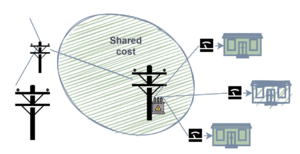Energy Efficiency in Humanitarian Infrastructure - A Practitioners Guideline
Energy Efficiency TIER-Approach
The analysis of energy efficiency options in humanitarian infrastructures is critical because energy supply is usually scarce and expensive in these locations. Actions for saving energy are shown in the following tiered approach:
| TIER 1 | Measurement of energy consumption is the first intervention to undertake. It is a prerequisite for all interventions because what cannot be measured cannot be improved. |
| TIER 2 | Next, energy conservation measures – often referred to as behavioural change - shall be implemented. Turning off appliances when they are not in use, closing doors and windows while running air conditioning, and switching off electric boilers when they are not in use are good examples. |
| TIER 3 | Once the previous points have been implemented, energy efficiency options associated with technological change can be considered like improving thermal efficiency of buildings or establishing procurement standards for energy efficient appliances. The objective is to reduce the energy consumption for a given service or level of activity. |
| TIER 4 | After contemplating and implementing the previous steps, renewable energy (RE) sources shall be considered. In this way, the new green power supply can result in significate cost-effectiveness, as it would be introduced into a pre-existing optimised power system. |
With a higher TIER, the amount of the necessary investments and the complexity of the measures also increase. Traditionally, RE power plants have been significantly more expensive and complex to implement than the interventions in Tier 2 and Tier 3. However, RE power plants, particularly solar PV power plants, have dramatically reduced in cost in the past decade. This, coupled with innovative financing and plug-and-play solutions, has transformed the market. Today Tiers 2, 3, and 4 could be easily re-grouped into a holistic solution in which energy conservation, technology upgrades, demand-response management, and renewable energy sources are comprehensively addressed and in terms of each factor’s impact on the other. Moreover, each kWh of electricity saved through energy efficiency measures represents a saving that can be directed to the core activity of humanitarian activities, thus resulting in a higher efficiency budget expenditure and greater operational results.
Energy Efficiency and Safety Guidelines
The following five fields of actions, which shall be undertaken to improve energy efficiency and reduce electrical and fire hazards in humanitarian infrastructures, are distinguished:
- Power Generation
- Power Distribution
- Appliances
- Buildings
- Behavioural Changes
Power Generation
Humanitarian organisations are encouraged to develop a road map for establishing a centralised energy monitoring system that will track energy consumption in their facilities. With internet connection, smart energy meters help collect data. Otherwise simple digital energy meters can be installed at the main electrical boards.Plug energy meters are also useful to check the power consumption of individual appliances. The operators shall record periodic energy readings and the instant power consumption can be used to find energy-intensive appliances.
Although use of diesel generators shall be reduced as much as possible because of their high operation costs and carbon emissions, it is not always possible to avoid them. Proper sizing of diesel generators is important to avoid energy losses, increased emissions and accelerated wearing. Oversizing diesel generators is a common malpractice, especially in humanitarian settings. It is often done because power needs are highly variable in these contexts – e.g., operations can increase due to a sudden migration flow and rapid response is needed. To solve this problem a few simple things can be done like setting a basis for correct sizing with energy meters or choosing diesel generators on an individual basis depending on the peak load.
In countries where the utility grid’s energy production has a substantive share of RE and the utility tariff is advantageous, humanitarian infrastructures are encouraged to consider connecting to the centralized national grid. Sharing the connection costs (extension of the medium voltage lines, installing a transformer and droplines) with nearby humanitarian organisations, shops, and institutions could dramatically cut the connection costs. Requesting for a larger, shared transformer is cheaper than installing a smaller, dedicated one.




















